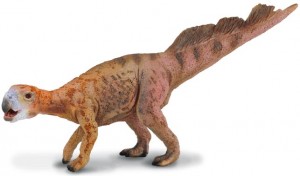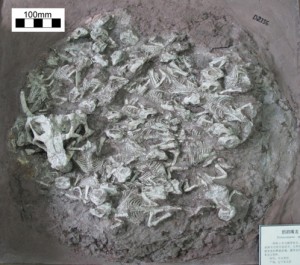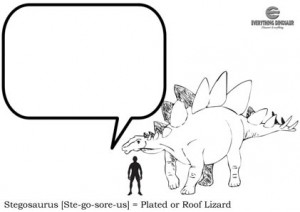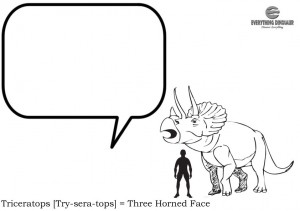Did Psittacosaurus Use Baby Sitters?
Palaeontologists Suggest Dinosaur Fossil Material Shows a “Creche” with Baby Sitter
A team of international researchers have re-examined a set of Psittacosaurus dinosaur fossils that come from the Lujiatun beds of the Yixian Formation in Liaoning, China. The rock slab has preserved the fossilised remains of twenty-four young psittacosaurs and one older individual. It has been suggested that the fossil represents a group of hatchlings being looked after by an older animal. Could this be evidence of a dinosaur “creche” with a “baby sitter”?
Published in “Cretaceous Research”
The paper on this new research has been published in the academic journal “Cretaceous Research”. The international team included University of Pennsylvania based scientists Brandon P. Hedrick and Peter Dodson as well as researchers from China’s Dalian Museum of Natural History, where the rock slab is currently stored. The fossil material was first described ten years ago, the block, which measures a little over sixty centimetres in length was discovered by an amateur palaeontologist, it is believed to date from around 120 million years ago (Aptian faunal stage of the Cretaceous).
Psittacosaurus
Psittacosaurus is one of the most studied of all the dinosaurs. A number of species have been assigned to the genus, it remains the most specious of all the Dinosauria, although some species have been described as nomen dubium following a recent review (2013). Seen as a transitional form between the ornithopods and the horned dinosaurs, Psittacosaurus is regarded as a basal member of the Marginocephalia. Rarely exceeding two metres in length, fossils of this herbivorous dinosaur have been found in China, Russia and Thailand.
An Illustration of Psittacosaurus
Picture credit: Everything Dinosaur
For models and replicas of Psittacosaurus (whilst stocks last) and other Cretaceous prehistoric animals: CollectA Prehistoric Life Figures and Models.
Psittacosaurus Dinosaur Fossils
Despite its spectacular appearance, the fossil material has only been briefly described, although the idea of a “dinosaur creche” has been proposed before. The exact location of the discovery was never recorded, this hampered the international research team but as PhD student Brandon P. Hedrick stated:
“I saw a photo of it [the block] and instantly knew I wanted to explore it in more depth.”
Dalian Museum of Natural History Slab of Fossil Material
Picture credit: Everything Dinosaur/University of Pennsylvania
Studying the Orientation of the Fossils
In order to learn more about how these dinosaurs may have died, the orientation of their bodies was carefully studied. Thin slivers of rock were examined under the microscope and further samples were subjected to X-ray diffraction. The analyses suggested that the matrix was composed of volcanic material, indicating that these prehistoric animals were caught in a flow of material as a result of a volcanic eruption. Since all the fossils were orientated in the same plane, the position of the fossils supports this idea that all these dinosaurs were engulfed in a flow.
As the fossilised bones showed no scorch marks or signs of heat damage, the researchers concluded that the flow was unlikely to be pyroclastic in nature.
Hedrick added:
“If they were captured in a flow, the long axis, their spines, would be orientated in the same direction. That was what we found. They were likely trapped by a flow.”
It is likely the flow was some sort of lahar – a mixture of water, mud, rock and other debris associated with volcanic eruptions.
Since no egg shell material has been found, it is believed that the twenty-four fossils represent a group of hatched dinosaurs. The larger skull was found in close association with the fossil material, it is likely that this larger Psittacosaurus perished at the same time as the younger animals.
Psittacosaurus lujiatunensis
All the psittacosaurs have been assigned to the same species Psittacosaurus lujiatunensis, the skull probably belonged to an immature adult, one not old enough to breed, so the researchers have hypothesised that this was an older sibling helping to care for its younger brothers and sisters.
Family members helping out to raise the following year’s brood is a type of behaviour found in a number of bird species. It has been estimated that around 8% of all, extant bird species are involved in some form of co-operative breeding in which other family members help to raise young. This behaviour is found in many types of song bird and the crow family for example. The scientists emphasise that this material cannot be regarded as a dinosaur “nest”.
Hedrick explained:
“It certainly seems like it might be a nest, but we were not able to satisfy the intense criteria to say definitely that it is. It is just as important to point out what we don’t know for sure as it is to say what we are more certain of.”
The scientists hope to continue their work by focusing on the micro-structure of the fossilised bones of the smaller dinosaurs to establish whether they were all at the same stage of development. If this is found to be the case, this would support the theory that this rock slab represents the preserved remains of one clutch or brood of animals.





